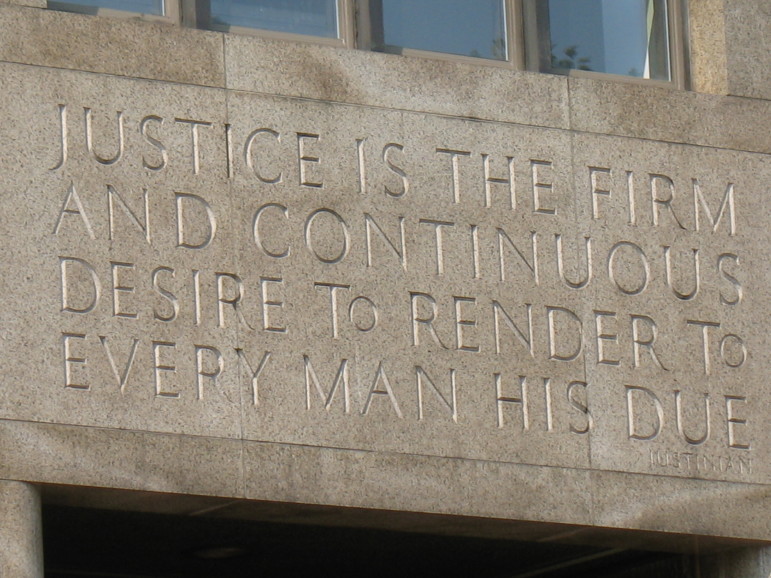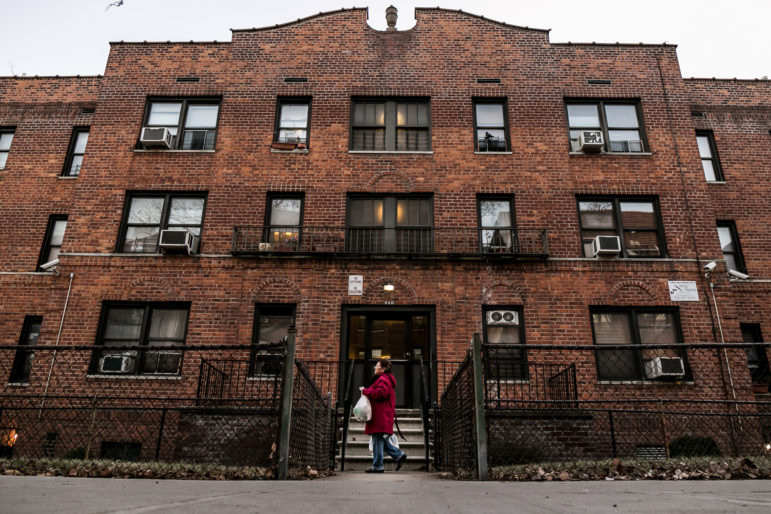In prison, there are two things to do for healthy recreation: pump iron or read. As a result, the library at Eastern New York Correctional Facility is filled with enormous men looking for books. They kill time in the reading room, leafing through magazines or newspapers while they wait to pick out a book. They watch a video. By threes, they may browse in the cramped stacks among the 11,000 titles. Shoulders and heads bob silently over the chest-high rows.
In the movies, the prison library is a sanctuary amid violence and horror, with long wooden tables for study, tall windows filtering pleasant light, meticulously kept stacks, a pet crow. Here, at this prison on the depressed edge of the southern Catskills, there are no wafts of espresso coming from a café. No sunlight at all, as a matter of fact. “Urine-colored walls, feces-colored tables, and institutional gray floors,” is how one inmate describes the place.
A correction officer surveys the library through windows that look in from the hall. A civilian clerk watches for theft in a traffic mirror hanging from a ventilation duct. Eastern is a maximum-security prison, and 85 percent of the men here are from New York City. They are doing long sentences for felonies like murder, drug dealing, and sex crimes, and they are constantly being watched. Most of the time, they don’t let on that they know, but they are always aware of it. An inmate, crouching in the stacks to see some titles, looks up into the mirror on the duct and catches me watching. He flashes me a peace sign.
I am here on a summer internship as I work toward my master’s degree in library science at the State University of New York at Albany. Many other students are spending the summer learning to be archivists, public librarians, or academic librarians, but I wanted to take the most interesting internship I could find. Here, I could work side by side with people who live in a world that few outsiders ever see. And unlike my coworkers, at the end of the day I could go home.
At Eastern, I spend every morning working alongside a part-time librarian and a clerk. The inmates do the bulk of the work, though, including interlibrary loan, cataloging, checking in books and shelving. Mostly, I just look over their shoulders. As a civilian, my role is technically supervisory, but many of them have been doing their job for years. I’d be meddling if I tried to offer advice.
The leader of the inmate clerks is Frank Fissette. This is not an elected position. Fissette leads by being the smartest, and by having a hard, indifferent attitude that others try to emulate. He is bored by people with no guts, and he has a sharp disdain for most correction officers.
Like a startling number of inmates in Eastern New York Correctional Facility, Fissette is a voracious reader. If you have any knowledge, Fissette will find a way to extract it from you. He has both a genuine curiosity and a dark charisma, and it’s hard to resist the impulse to try to entertain and impress him.
Fissette doesn’t meet many grad students, and in me, he evidently believes he has hit the intellectual jackpot. But before he can start mining my brain, he has to make sure I meet his standards.
On my third day in the library, it’s empty except for me and a few of the inmate clerks. Fissette lights a cigarette. Smoking among the books is, of course, anathema to a librarian. This is a test of my authority, and my willingness to use it. He’d think I was spineless if I ignored him. But I’d be despised if I called the C.O. or pressed my emergency beeper. I’m being asked to show my colors, and reveal where I stand. Am I a potential ally, or just another amateur cop?
“What, are you kidding, Mr. Fissette? Put that out,” I say. I’m nervous, but I also resent that he’s toying with me. He does not put it out.
This is not what I signed up for. What I expect to do as a librarian is to inform, enlighten and agitate. But at Eastern–and at all prisons–the librarian must serve two masters. The first is the old ideal that brought me here: the conviction that books and reading can change men’s lives. But in the modern prison, there’s a more mundane reason why libraries remain despite budget cuts and tough-on-crime politics. They keep inmates quiet. If an inmate is in the library or reading, goes the thinking, then he isn’t in the yard with the gangs. Here at Eastern, I am learning how to be a librarian, but I’m also expected to be something of a custodian. The line is indistinct.
The other inmates and Fissette continue talking. “Put it out,” I say again. “If it bothers you,” he replies over the live cigarette, “I’ll put it out. But if you’re just going to squeal on me….”
He’s given me an out. “It bothers me,” I tell him. Fissette smiles, hauls his feet from the desk to the cement, and stubs it out.
When he reads this, Fissette will laugh if I suggest that I won his trust. In a maximum security prison, there is little traffic in trust between inmates and civilians. But perhaps he’d agree that I have at least not earned his contempt.
The dramas in prison usually play out like the cigarette incident. They are small, charged maneuvers that carry a lot of psychological freight. But in the library, these potent interactions are slightly less loaded. There are occasional exceptions to the rigid laws of authority and power. The possibility for something approaching a normal human friendship still remains.
Fissette’s little game is probably the most important moment in my summer, the difference between staying locked out of the prisoners’ world, relegated to being an outsider, a civilian, a jailer–or getting a chance to understand why this library is so important to these men. It’s the beginning of my education in what it means to be a prison librarian.
_______
At a maximum-security prison, there are few diversions as powerful as a good book. At public and school libraries, the staff must lure patrons in with clever advertising and the Internet. Here at Eastern, the surroundings may be grim and the resources minimal, but the customers are absolutely devoted. In a completely unexpected way, it’s a librarian’s paradise.
The men are avid and thorough readers, and they are desperate for new books. About two-thirds of the prison’s 900 inmates use the library, and new releases–a true crime novel, the latest in a popular street fiction series–become precious commodities. Inmate reading varies widely, but there are themes. Often, men choose by writer, reading each one of an author’s works in turn. A series must be read in order; installments are anxiously awaited. Patrons eagerly inquire about the books they’ve ordered through interlibrary loan from the local system. Fissette fulfills up to 30 of these requests each week.
Browsing through stacks of best-sellers is a modern concept in incarceration. On the Hulks, the 18th-century floating prisons that ferried criminals from England to Australia, the library collections were carefully chosen to guide prisoners to the righteous path. A ship’s chaplain usually directed the collection, with predictable results. According to library historians Tony Stevens and Bob Usherwood, a prisoner on the way to a new life in Australia might have read Syneg’s Answers to All Excuses for not Coming to the Holy Communion, or, perhaps, The Evil Consequences of Attending the Race Course. Dickens’ reformist Household Words was banned because it didn’t foster decency.
Now that keeping inmates quiet is more of a priority than keeping them pure, catalogs are organized on the ethos of the public library: Give the customer what he wants. Pauline Lewis, Eastern’s librarian, takes this consumer-friendly credo seriously. The New York State budget covers about $20 per inmate per year for books and other materials, and the prison librarian has nearly free rein on how to spend the money. So Lewis continuously checks newspaper and magazine subscriptions against the desires of a fickle inmate population, making sure that the catalog matches up with demand. During one of her regular meetings with the inmate clerks, she ends a subscription duplicating news from China and replaces it with a daily newspaper to appease men from Buffalo.
With the books, the collection’s mandate translates into a mix of paperback pulp fiction and classics. Donald Goines and Iceberg Slim, the two dons of the Street Literature genre, fill their potboilers with drugs, violence and prostitution. Inmates can read Stephen King’s Misery, The Autobiography of Malcolm X, or Goines’ Whoreson. Books in Spanish, Russian and Chinese command increasing proportions of shelf space, but certain topics are off-limits: how-to books on martial arts, explosives manuals, aggrandizements of pedophilia, road maps.
The easiest way to track the most popular books at Eastern Correctional is to look for what is missing. Self-help books, religious works and information on post-release life are never stolen. Books with pictures of dogs get lifted. Strangely, Shakespeare walks. All that is left on the shelves is The Encyclopedia of Shakespeare–shelved in the reference collection, where prisoners must surrender an ID in exchange for a book. Locking glass cases also protect the most desirable new books, the videos and popular special collections like African-American literature. The only way to minimize theft, a phenomenon that plagues libraries everywhere, is to keep patrons out of the stacks. But Lewis is more interested in maintaining the balance of trust than maintaining all the books in the collection, and therefore allows inmates to browse the stacks.
For some motivated inmates, prison becomes a substitute for college–a chance to acquire a classical education. By the librarian’s creed, I don’t ask about these men’s crimes, but I know that many of them spent their school years in prison or on the street. New York State requires prisoners to work toward a GED, but options for college education are nil unless an inmate can find a private sponsor. As a result, the exceptional self-educators mostly rely on the library.
It is inevitably frustrating, because there is no way a prison library can stand in for a school or university. The Internet is banned, and prospective scholars are short on options for further courses. Yet the persistence of some men is astonishing. Some take advantage of other prison programs to train and learn new skills, like Braille translation. Others find sponsors to pay for correspondence courses. Men often ask me for school reading materials like language-learning books, or books of literary criticism. One inmate, during question-and-answer with a visiting author, calls out for a booklist of “what they’re reading in college.” It occurs to me, sometimes, to be jealous of how much some inmates read.
_______
With his dark hair swept back off his forehead and tattoos decorating his muscular forearms, Frank Fissette, who is serving a 25-to-life sentence for murder, is every inch the pin-up felon. And he knows it. It’s a role he consciously plays, with both nuance and gusto.
His relationship with those around him hinges on an absolute code of honor. In the stories he tells, there are only two kinds of people. There are rats who betray, and there are admirable criminals who keep their word.
Yet Fissette is also a model prisoner, who has managed to impress prison officials as much as his fellow inmates. The administrators respect his tenacity and his intelligence; he’s now working on a bachelor’s degree from Empire State, thanks to a benefactor who pays for his classes. The other men admire his menace, which extends to his control over the library.
Like anything else of value in prison, new books have their own economy. Prisoners are always desperate to keep up with what’s happening on the outside. One inmate, Rich Kirkwood, says that his wife gives him a technology update each week: e-mail, call waiting, E-Z Pass. “But it’s not the same as the real thing,” he says. Many have never seen the Internet. To keep current, most men in prison rely on books, magazines, and newspapers in the library. The demand for new reading material is steady and intense.
Supply is in the hands of Fissette and Kirkwood, who control the books right up to the point when they are shelved. The men are territorial about their jobs, with a proprietary, almost obsessive attention to the details of the work. For one thing, these jobs are slightly less boring than most of the other ones in prison. More importantly, in a place where power is at a premium, controlling anything–even a fresh copy of A Perfect Storm–has its rewards. Tiny reservoirs of command become decisive.
When new books come in, it is Rich Kirkwood who enters them into the computer and labels them. With great flourish, he slaps red “Eastern” stamps in every conceivable place in the book, decorating the binding, cover, all edges, and almost every page.
But all the drama with the red stamp appears to be reserved for works less in demand. It soon becomes clear that there are certain new titles that don’t go directly to the shelves, as well as books that get returned directly to Fissette or Kirkwood instead of through the usual procedures. The two men, I come to discover, run the library’s black market. As far as I can tell, it’s a titles-for-favors scheme: Certain people get first crack at new books in return for cigarettes, snacks, loyalty. This illicit system, like others in prison, is closer to patronage than it is to larceny. The currency here is favors.
But though I pry mightily, neither man will reveal the exact terms or mechanism of this arrangement. Kirkwood insists, “It’s just some books for friends, people I trust. If I didn’t do it, some stupid m.f.’er would steal the books. Then what? Who’d get to read ’em then?”
This argument prevails with Lewis, who tolerates the shadow book club. But I know there is more to it when Fissette splits with me a warm, buttery egg sandwich, covered in cheese on a fresh-baked roll. I was told that the guy who brought it likes fantasy books. “When you’re good to people, they need to be good back, right?” asks Fissette, grinning.
_______
In the early part of the century, prison libraries were still mostly an afterthought, a collection of books chosen primarily for their dreary purity. In 1928, not one of the country’s 110 federal penitentiaries had a trained librarian. But as the profession of librarianship began to muscle its way into institutions, librarians increasingly took posts behind bars. By 1940, half the federal prison libraries boasted a librarian.
At that point, the library was still a tool of the jailers, a means to mold and shape the inmates. The prison librarian’s job was to simply collect and organize the books prescribed by the administration to foster positive change and moral betterment. Any other kinds of reading were, as Stevens and Underwood put it, “considered to be ‘mental dope’ and indicative of sloth.”
After World War II, correctional philosophy, having failed to solve the problem of criminal behavior, mutated again. Instead of remolding the criminal into an acceptable member of society, the hope was now to unlock the inner citizen. The idea that crime was a type of treatable illness became pervasive in correctional theory. Where before an inmate went to prison to change, he now went to be cured. The basic premise, in the words of correctional researcher Mick Ryan, was, “Where hard work and God had failed, group therapy and Freud were to succeed.”
So it only made sense that ambitious reformers borrowed the tools of rehabilitation from mental health institutions. One of those ideas was bibliotherapy, the doctrine that therapeutic reading could cure the afflicted through a process of self-actualization. Bibiliotherapy promised to cure by changing attitudes, motivation and behavior through the medicine of assigned reading and discussion. Inmates would get to know themselves through a kind of personal and intellectual catharsis, by identifying with the characters and situations in fiction. Reading and discussion might give inmates insight and vocabulary to discuss their own problems more accurately in therapy. And literature could also help with socialization, by suggesting interesting conversations on healthy topics. This is the stuff librarians dream of. The power of literature could finally be harnessed to correctional ends; the unification of prison and library was complete.
With bibliotherapy, the role of prison libraries and librarians in the 1950s and 1960s expanded. No longer a mere archivist and information expert, the librarian also became something of a personal guide, leading book discussions and helping prisoners with individual directed reading. And as the librarian took on part of the therapist’s role and the library became something akin to a clinic, the expectations for what books and libraries should accomplish also became more complex. Bibliotherapy and other similar programs were expected to produce cured criminals who would lead well-adjusted lives once they returned to free society. Lowering recidivism may have always been the Holy Grail of corrections, but by the 1960s it had become an implicit justification for funding prison libraries as well.
In 1966, this doctrine was put to the test. New York State was in the middle of an ambitious effort to develop programs that would employ state-of-the-art methods to keep the state’s nearly 16,500 inmates from returning to prison. In the best traditions of social science, the state Department of Corrections recruited a researcher named Robert Martinson to do an exhaustive survey, analyzing hundreds of rehab programs and reams of statistics on recidivism in order to find out what really works.
Four years and 231 reviews later, Martinson’s answer came, weighing in at 1,400 pages. But the study’s conclusions were discouraging–so dismal that the state refused to release the results. Finally, four years later and under subpoena, the state made the review public. “It is possible to give a rather bald summary of our findings,” writes Martinson in The Public Interest, the first published account of his study. “With few and isolated exceptions the rehabilitative efforts that have been reported so far have had no appreciable effect on recidivism.” In one crashing moment, corrections experts found that some of their most cherished assumptions about what it takes to rehabilitate a criminal had evaporated. Martinson’s report concluded, in painful detail, that nothing works.
It was a bombshell. After the Martinson study, correctional theorists and prison program directors scrambled to justify their efforts, and in the three decades since then sociologists, politicians and activists have continued to battle over the efficacy of correctional work. The formidable idea that “nothing works” destroyed the momentum behind rehabilitative services, and spelled the beginning of the end for bibliotherapy.
But incarceration’s next crisis came unexpectedly to the rescue. As violence and gangs laid siege to prisons in the 1970s and 1980s, administrators realized that libraries serve another important purpose–namely, security. Libraries sedate. The cost of some books and a librarian is, after all, much lower than the price of an institution in turmoil. Professor Shadd Maruna, a corrections specialist at SUNY Albany, says that the politics of criminal justice have kept rehabilitation programs afloat ever since. Today, he observes, a prison administrators’ goal “is really to keep a lid on the shop and make sure you don’t wind up on the front pages of the Times for whatever reason. Keep the prison out of the news, keep the prisoners inside where they are supposed to be, and don’t embarrass the governor.”
As a result, much of what the library does is merely palliative, and colludes with the other parts of the prison to keep things quiet. But if they believed crowd control was their only function, librarians would flee from prisons. The library, and the librarian too, work a paradox. Help men by control, control men by help. It’s something they don’t teach in library school.
_______
Among New York’s prisons, Eastern Correctional has a reputation for taking its library more seriously than most, and as more than a token gesture to public safety. Bibliotherapy may be passé, but a book group of 18 men meets weekly, reading titles selected by the inmates: Guterson’s Snow Falling On Cedars, Dexter’s Paperboy, Proulx’s The Shipping News. A professor from one of the nearby colleges sometimes comes in to lead the discussion. A local poet has volunteered to lead a writing group in the prison, and the men publish their most polished work.
The prison also hosts a writing contest, with a judges’ panel that includes me, Fissette, an inmate who writes haiku and a few civilians. We are overwhelmed with entries. Men just learning how to spell, as well as published writers, give us works to consider. Almost every one is about the experience of prison itself, either stark physical descriptions, essays on oppression or poems of loneliness and loss.
Now that inmates are barred from state and federal education grants for college, Eastern can no longer sustain a higher education program. The prison still does host programs for high school equivalency classes, which rely on the library for books and research.
During my first week, the English teacher brings her 25 students to the library for Wednesday morning class. The library is at maximum capacity, and the men are restless and noisy. Quickly, it gets to the point where I try to quiet them. “Hello. Please…Yo!” Yelling only brings them to a louder pitch. I have no control.
Then Pauline Lewis steps up. Like a symphony conductor, she raises her hands. “Gentlemen,” she says softly. The inmates fall silent. “You know that I shouldn’t have to remind you that you are in a library. This is Mr. Sample. He will be spending the summer with us. He is here to help you, so please welcome him.” After scattered “hellos,” the inmates tone down for the rest of the time. Lewis comes from the New York Public Library system, where she developed literacy programs and worked to bring library services to nursing homes and hospitals. When she moved upstate in 1989, her talents naturally fit in at Eastern.
Lewis has found a way to be both firm and gracious, and these tough men are as respectful as they can be to this slight woman in her fifties. It’s a level of regard that few who work at Eastern can count on. On my first day at Eastern, as she escorted me through the warren of halls and clanging gates, we were greeted by a continuous chorus of “Good morning, Mrs. Lewis”es from the inmates as we passed. Even the correction officers bow a bit in greeting her. “Mrs. Lewis is the best person I know,” Fissette says.
Martinson’s “nothing works” is easy to cite, and easy to argue over. But for Pauline Lewis, as for other prison librarians, the recidivism figures that obsess the academics and administrators are almost irrelevant. And like many others in her profession, Lewis is not particularly drawn by the dusty charm of books. Her work is based on a more precise and realistic faith: that information, and access to information, is the most powerful tool she can provide to these men. “I am not a lover of books,” she says to me, in her airy Jamaican accent. “I became a librarian because it is a service profession.”
It may seem trivial, but one of the most important things Lewis does is simply convert inmates into library patrons. A man leaving prison may have no job and no house, but he also can be at sea in more profound ways. When he walks out the door, he is suddenly stripped of the daily routines and habits that have shaped him for years. The library can be a refuge, helping him find a job and a place to live. It also can provide cheap entertainment, and a way to constructively engage in a community.
“We really believe, most of us that are in prison library work, that the work we do, if we are successful at getting inmates to come into the library, prepares them for a return to the street,” says Jean Botta, the supervising librarian for the New York State Department of Correctional Services.” We are preparing them for better use of the public library.”
In New York State, libraries are still required by law, and they are still being designed into the new prisons being built upstate. But a 1996 New York Commission on Corrections report essentially recommended an end to prison libraries in New York State. Starve the libraries, the commission suggested, cease buying books and materials, and abolish the requirement for a professional librarian. Helping inmates, entertaining them or simply pacifying them is no longer as important as making the prisons cheaper to run.
I ask Fissette what would happen with no library in prison. “There will always be books in here,” he says sharply. Clearly, no policy change is going to keep him from reading, and laying his hands on new books.
But books for whom, I ask? Fissette himself was not a reader when he was sentenced to prison, and he had no interest in education until he took a couple classes on a whim and realized that he was good at it. A clutch of inmates–there are always people nearby–hassles Fissette into conceding that they need the library, at least to give the other men the chance that he had.
This year, Pauline Lewis retired from Eastern. But she says it is hard to leave, and that she will miss the inmates. “I know that they are criminals, but really they have become a part of my life,” she says. Lewis is adamant that Eastern’s library should continue to be run by a professional. Right now, though, the woman in charge is a civilian with no formal training. It gets me thinking. After watching Lewis all summer long, I am no longer so queasy about the idea of working for a prison. Her conscience is clear. She has accepted her role as a jailer in order to help the people who need it most.
By spending years or decades in prison, these men miss out on almost everything life has to offer: an education, a profession, a social life, a family. The idea that a well-run library could begin to compensate for any of that is a joke. With so little to point to for pride, though, the library grants them small opportunities for victory. It seems to me that even finishing a book marginally increases their chances for survival both in and out of prison. It gives them something to call their own. For a librarian, that’s the ultimate job satisfaction.
To Fissette, I’m still a “rich suburban kid with an unnatural affinity for khaki pants.” Yet I am also a trained librarian, and Fissette and Kirkwood have started lobbying me to be Lewis’ successor. Normally, candidates for the job have to ascend the civil service list in order to get their pick of openings in the prisons. But Fissette has a plan to get me on the fast track. “Take hostages,” he suggests with a wide grin.
Holbrook Sample is a reference librarian and freelance writer.









One thought on “The Great Escape”
Pauline Lewis. We love and miss you Miss Lewis. You are truly a gift to this world.